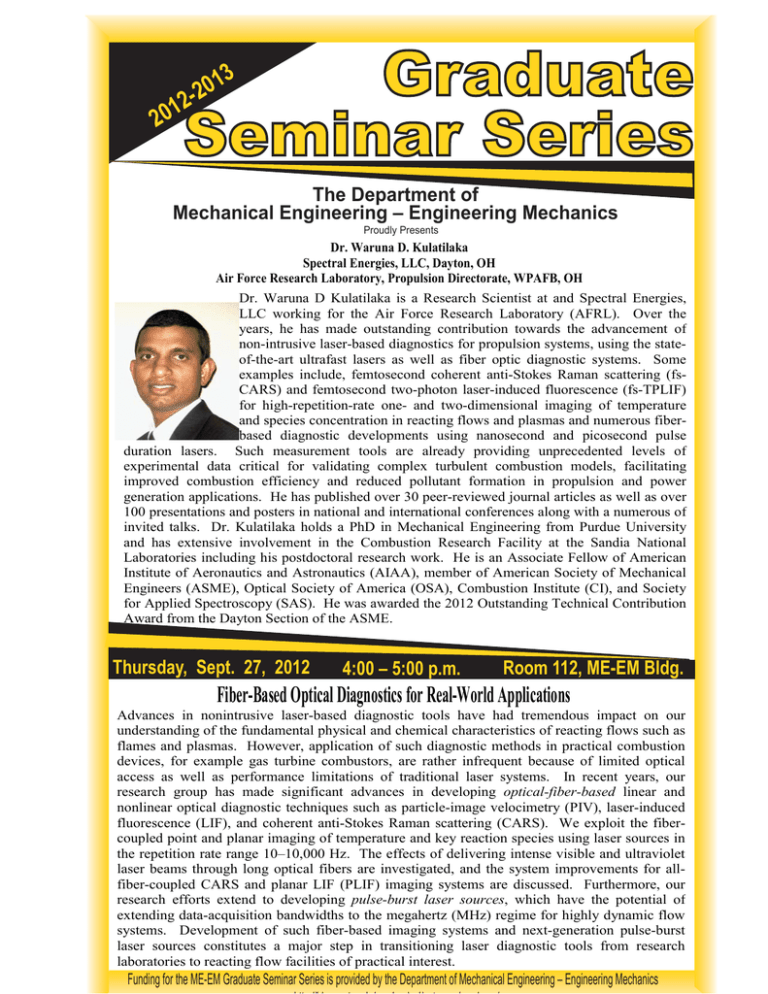Graduate Seminar Series 2012-2013 The Department of
advertisement

Graduate Seminar Series 3 01 2 2 201 The Department of Mechanical Engineering – Engineering Mechanics Proudly Presents Dr. Waruna D. Kulatilaka Spectral Energies, LLC, Dayton, OH Air Force Research Laboratory, Propulsion Directorate, WPAFB, OH Dr. Waruna D Kulatilaka is a Research Scientist at and Spectral Energies, LLC working for the Air Force Research Laboratory (AFRL). Over the years, he has made outstanding contribution towards the advancement of non-intrusive laser-based diagnostics for propulsion systems, using the stateof-the-art ultrafast lasers as well as fiber optic diagnostic systems. Some examples include, femtosecond coherent anti-Stokes Raman scattering (fsCARS) and femtosecond two-photon laser-induced fluorescence (fs-TPLIF) for high-repetition-rate one- and two-dimensional imaging of temperature and species concentration in reacting flows and plasmas and numerous fiberbased diagnostic developments using nanosecond and picosecond pulse duration lasers. Such measurement tools are already providing unprecedented levels of experimental data critical for validating complex turbulent combustion models, facilitating improved combustion efficiency and reduced pollutant formation in propulsion and power generation applications. He has published over 30 peer-reviewed journal articles as well as over 100 presentations and posters in national and international conferences along with a numerous of invited talks. Dr. Kulatilaka holds a PhD in Mechanical Engineering from Purdue University and has extensive involvement in the Combustion Research Facility at the Sandia National Laboratories including his postdoctoral research work. He is an Associate Fellow of American Institute of Aeronautics and Astronautics (AIAA), member of American Society of Mechanical Engineers (ASME), Optical Society of America (OSA), Combustion Institute (CI), and Society for Applied Spectroscopy (SAS). He was awarded the 2012 Outstanding Technical Contribution Award from the Dayton Section of the ASME. Thursday, Sept. 27, 2012 4:00 – 5:00 p.m. Room 112, ME-EM Bldg. Fiber-Based Optical Diagnostics for Real-World Applications Advances in nonintrusive laser-based diagnostic tools have had tremendous impact on our understanding of the fundamental physical and chemical characteristics of reacting flows such as flames and plasmas. However, application of such diagnostic methods in practical combustion devices, for example gas turbine combustors, are rather infrequent because of limited optical access as well as performance limitations of traditional laser systems. In recent years, our research group has made significant advances in developing optical-fiber-based linear and nonlinear optical diagnostic techniques such as particle-image velocimetry (PIV), laser-induced fluorescence (LIF), and coherent anti-Stokes Raman scattering (CARS). We exploit the fibercoupled point and planar imaging of temperature and key reaction species using laser sources in the repetition rate range 10–10,000 Hz. The effects of delivering intense visible and ultraviolet laser beams through long optical fibers are investigated, and the system improvements for allfiber-coupled CARS and planar LIF (PLIF) imaging systems are discussed. Furthermore, our research efforts extend to developing pulse-burst laser sources, which have the potential of extending data-acquisition bandwidths to the megahertz (MHz) regime for highly dynamic flow systems. Development of such fiber-based imaging systems and next-generation pulse-burst laser sources constitutes a major step in transitioning laser diagnostic tools from research laboratories to reacting flow facilities of practical interest. Funding for the ME-EM Graduate Seminar Series is provided by the Department of Mechanical Engineering – Engineering Mechanics





